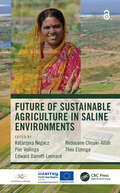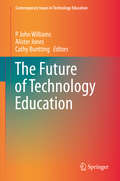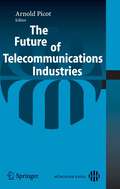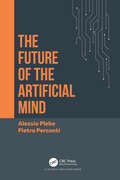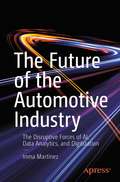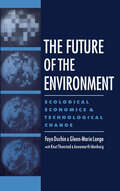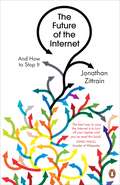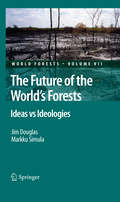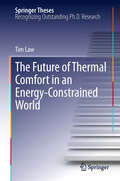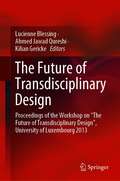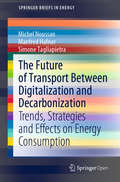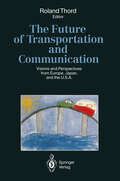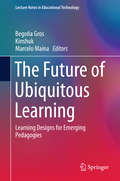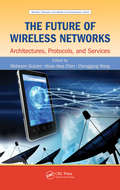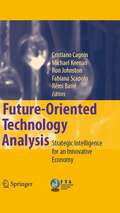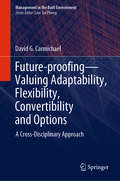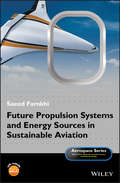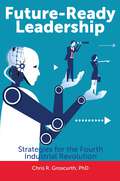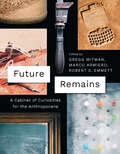- Table View
- List View
Future of Sustainable Agriculture in Saline Environments
by Katarzyna NegaczFood production on present and future saline soils deserves the world’s attention particularly because food security is a pressing issue, millions of hectares of degraded soils are available worldwide, freshwater is becoming increasingly scarce, and the global sea-level rise threatens food production in fertile coastal lowlands. Future of Sustainable Agriculture in Saline Environments aims to showcase the global potential of saline agriculture. The book covers the essential topics, such as policy and awareness, soil management, future crops, and genetic developments, all supplemented by case studies that show how this knowledge has been applied. It offers an overview of current research themes and practical cases focused on enhancing food production on saline lands. FEATURES Describes the critical role of the revitalization of salt-degraded lands in achieving sustainability in agriculture on a global scale Discusses practical solutions toward using drylands and delta areas threatened by salinity for sustainable food production Presents strategies for adaptation to climate change and sea-level rise through food production under saline conditions Addresses the diverse aspects of crop salt tolerance and microbiological associations Highlights the complex problem of salinity and waterlogging and safer management of poor-quality water, supplemented by case studies A PDF version of this book is available for free in Open Access at www.taylorfrancis.com. It has been made available under a Creative Commons Attribution-Non Commercial-No Derivatives 4.0 license.
Future of Sustainable Agriculture in Saline Environments
by Katarzyna Negacz Pier Vellinga Edward Barrett-Lennard Redouane Choukr-Allah Theo ElzengaFood production on present and future saline soils deserves the world’s attention particularly because food security is a pressing issue, millions of hectares of degraded soils are available worldwide, freshwater is becoming increasingly scarce, and the global sea-level rise threatens food production in fertile coastal lowlands. Future of Sustainable Agriculture in Saline Environments aims to showcase the global potential of saline agriculture. The book covers the essential topics, such as policy and awareness, soil management, future crops, and genetic developments, all supplemented by case studies that show how this knowledge has been applied. It offers an overview of current research themes and practical cases focused on enhancing food production on saline lands. FEATURES Describes the critical role of the revitalization of salt-degraded lands in achieving sustainability in agriculture on a global scale Discusses practical solutions toward using drylands and delta areas threatened by salinity for sustainable food production Presents strategies for adaptation to climate change and sea-level rise through food production under saline conditions Addresses the diverse aspects of crop salt tolerance and microbiological associations Highlights the complex problem of salinity and waterlogging and safer management of poor-quality water, supplemented by case studies A PDF version of this book is available for free in Open Access at www.taylorfrancis.com. It has been made available under a Creative Commons Attribution-Non Commercial-No Derivatives 4.0 license.
The Future of Technology Education (Contemporary Issues in Technology Education)
by P John Williams Alister Jones Cathy BunttingTwenty-five years ago there was increasing optimism in policy, curriculum and research about the contribution that technology education might make to increased technological literacy in schools and the wider population. That optimism continues, although the status of technology as a learning area remains fragile in many places. This edited book is offered as a platform from which to continue discussions about how technology education might progress into the future, and how the potential of technology education to be truly relevant and valued in school learning can be achieved. The book results from a collaboration between leading academics in the field, the wider group of authors having had input into each of the chapters. Through the development of a deep understanding of technology, based on a thoughtful philosophy, pathways are discussed to facilitate student learning opportunities in technology education. Consideration is given to the purpose(s) of technology education and how this plays out in curriculum, pedagogies, and assessment. Key dimensions, including design, critique, students’ cultural capital are also explored, as are the role and place of political persuasion, professional organisations, and research that connects with practice. The discussion in the book leads to a conclusion that technology education has both an ethical and moral responsibility to support imaginings that sustain people and communities in harmony and for the well being of the broader ecological and social environment.
The Future of Telecommunications Industries
by Arnold PicotThis book contains the results of a symposium organized to ask what kind of future old and new players in the telecommunications industries will have given the dynamic changes in technologies and markets. The symposium combined perspectives from industrial practice and academic research originating from North America and Europe. Key issues featuring here are the technological drivers of change, changing market structures and business models, and the nature of future regulation on telecom markets.
The Future of the Artificial Mind
by Pietro Perconti Alessio PlebeThe Future of the Artificial Mind is about the social and technological challenges posed by the new wave of artificial intelligence, both from a technical and a cognitive perspective. Deep neural networks have brought about tremendous technological improvements. This renaissance in artificial intelligence, after decades of stagnation, has enabled new technologies capable of surpassing human performance, as in the case of visual recognition. The book reviews the key ideas that have enabled these goals to be achieved and their historical origins. The book also considers some of the ethical and social challenges that the future development of artificial intelligence will face. Will humans fall in love with future android dolls? What will artificial sex be like? And what will it be like to travel in cars that will treat us as passengers instead of drivers? But predicting the future appears more magic than science. But when it comes to artificial intelligence, it is a constant temptation. Since it is well known that "the only way to get rid of a temptation is to enjoy it!", the hypothesis considered in the last chapter is that emerging trends point to a near future in which intelligence will be ubiquitous, but it will be difficult to identify its bearer. We may be heading towards an era of widespread intelligence, but an intelligence without accountability.
The Future of the Artificial Mind
by Pietro Perconti Alessio PlebeThe Future of the Artificial Mind is about the social and technological challenges posed by the new wave of artificial intelligence, both from a technical and a cognitive perspective. Deep neural networks have brought about tremendous technological improvements. This renaissance in artificial intelligence, after decades of stagnation, has enabled new technologies capable of surpassing human performance, as in the case of visual recognition. The book reviews the key ideas that have enabled these goals to be achieved and their historical origins. The book also considers some of the ethical and social challenges that the future development of artificial intelligence will face. Will humans fall in love with future android dolls? What will artificial sex be like? And what will it be like to travel in cars that will treat us as passengers instead of drivers? But predicting the future appears more magic than science. But when it comes to artificial intelligence, it is a constant temptation. Since it is well known that "the only way to get rid of a temptation is to enjoy it!", the hypothesis considered in the last chapter is that emerging trends point to a near future in which intelligence will be ubiquitous, but it will be difficult to identify its bearer. We may be heading towards an era of widespread intelligence, but an intelligence without accountability.
The Future of the Automotive Industry: The Disruptive Forces of AI, Data Analytics, and Digitization
by Inma MartínezNothing defined the 20th century more than the evolution of the car industry. The 2020 decade will see the automotive industry leap forward beyond simply moving people geographically toward a new purpose: to become a services industry. This book takes readers on a journey where cars will evolve towards becoming “computers on wheels."The automotive industry is one of the sectors most profoundly changed by digitalization and the 21st century energy needs. You'll explore the shifting paradigms and how cars today represent a new interpretation of what driving should be and what cars should offer. This book presents exciting case studies on how artificial intelligence (AI) and data analytics are used to design future cars, predict car efficiency, ensure safety and simulate engineering dynamics for its design, as well as a new arena for IoT and human data. It opens a window into the origins of cars becoming software-run machines, first to run internal diagnostics, and then to become machines connected to other external machines via Bluetooth, to finally the Internet via 5G.From transportation to solving people’s problems, The Future of the Automotive Industry is less about the technology itself, but more about the outcomes of technology in the future, and the transformative power it has over a much beloved item: cars.What You’ll LearnExplore smart cities and their evolution when it comes to traffic and vehiclesGain a new perspective on the future of cars and transportation based on how digital technologies will transform vehicles Examine how AI and IoT will create new contexts of interactions with drivers and passengers alikeReview concepts such as personalizing the driving experience and how this will take formSee how self-driving cars impact data mining of personal dataWho This Book Is ForAnyone with an interest in digital advancements in the automotive industry beyond the connected car.
The Future Of The Environment: Ecological Economics And Technological Change
by Faye Duchin Glenn-Marie LangeOne of the most important and complex problems facing both developing and industrialized nations is how to sustain economic growth without harming the environment. Faye Duchin and Glenn-Marie Lange address this issue in a practical and realistic way: through a detailed evaluation of the well-known approach to sustainable development outlined in the Brundtland Report,Our Common Future. Taking issue with the Brundtland Report's optimistic and widely accepted assumptions, the authors show that the positive effects of recycling, increased fuel-efficiency, and other technological adjustments will not go far enough to provide for truly sustainable development in the long term. Through a new, broad-based empirical analysis, they argue that unless there are significant changes in lifestyles and the use of technologies, continued environmental degradation cannot be avoided. They warn that the trend of making only slight adjustments in the use of technologies, while feasible from an economic point of view for industrialized nations, will undoubtedly lead to further environmental damage. In addition to offering a clear and unflinching look at what development is really doing to the global environment, the unique conceptual framework developed for this analysis provides an invaluable basis for analysis for the new, multidisciplinary field of ecological economics. Duchin and Lange describe how this new methodology will enable economists and policy-makers to evaluate our options for the future, and choose those that most effectively reduce environmental degradation and achieve sustainable development. The book will appeal to economists, environmental scientists and activists, policy analysts, and ecologists, as well as the general reader with an interest in the sustainable development of our environment.
The Future of the Internet: And How to Stop It
by Jonathan ZittrainIn The Future of the Internet: And How to Stop It Jonathan Zittrain explores the dangers the internet faces if it fails to balance ever more tightly controlled technologies with the flow of innovation that has generated so much progress in the field of technology. Zittrain argues that today's technological market is dominated by two contrasting business models: the generative and the non-generative. The generative models - the PCs, Windows and Macs of this world - allow third parties to build upon and share through them. The non-generative model is more restricted; appliances such as the xbox, iPod and tomtom might work well, but the only entity that can change the way they operate is the vendor.If we want the internet to survive we need to change. People must wake up to the risk or we could lose everything.
The Future of the World's Forests: Ideas vs Ideologies (World Forests #7)
by Jim Douglas Markku SimulaAt the landmark 1992 United Nations Conference on Environment and Development (Earth Summit), solemn resolutions were made both to protect the world’s biodiversity and to co-operate on managing natural forests in a sustainable and ecologically responsible way. If anything, given recent developments in issues such as climate change and poverty, the problem of protecting and sustaining forests should logically have become more important globally. Yet public interest in, and development support for, forest activities have declined and rates of forest loss remain stubbornly high. Why has this happened? This book seeks answers to this question. It examines the often dysfunctional relationships between various members of the international forest constituency, which have so often prevented the formation of consensus. It also explores the tendency to pursue technical and politically convenient ‘fixes’ focused on the internal workings of the forest sector, while ignoring the overwhelming influence of external forces on the fate of forests. The result, all too often, has been programs which benefit a few powerful players and fail to provide real solutions. The book provides a new examination of and perspective on the international forest policy debate. It clarifies the reasons for global forest conflicts and provides insight for future policy development. Including examples from both the developed and developing world, it provides an invaluable resource for researchers and graduate students in forest policy and international relations, as well as a useful reference for policymakers and professionals in the forest sector, the development community and conservationists. With significant global attention now focused on reducing carbon emissions from deforestation and forest degradation (REDD), the authors examine the promise and the potential problems that apply to this initiative.
The Future of Thermal Comfort in an Energy- Constrained World (Springer Theses)
by Tim LawThe dissertation investigates the scientific and business factors that have resulted in air-conditioning being a major contributor to climate-change. With his architectural background, the author demonstrates how a design methodology, not commonly adopted in scientific studies, may actually be a suitable way of dealing with a complex problem: the 'business as usual' scenario involving building science, sociological values and consumer behavior. Using his innovations as case studies, the author shows how good ideas cannot be evaluated on scientific merit alone and demonstrates why commercialization may have a pivotal role in deployment of research-based technology. He advances the theory of personalized thermal comfort which can potentially resolve the air-conditioning conundrum.
The Future of Transdisciplinary Design: Proceedings of the Workshop on “The Future of Transdisciplinary Design”, University of Luxembourg 2013
by Lucienne Blessing Ahmed Jawad Qureshi Kilian GerickeThis book presents the state-of-the-art research in the field of transdisciplinary design, and highlights the challenges and issues from the perspectives of processes, people and products in transdisciplinary product design and development. It collates research papers resulting from the ‘Workshop on the Future of Transdisciplinary Design’ written by leading researchers in engineering design and product development. The papers provide examples and case studies from existing practices, as well as future perspectives towards the development of the complex and ever-changing domains of engineering design and product development, with an emphasis on transdisciplinarity. ‘The Future of Transdisciplinary Design’ contains a selection of research papers in the following areas related to transdisciplinary design: -Approaches-Tools and methods-Management and collaboration-Distributed and culturally diverse teams-Modeling, representing and managing information-Education and training A transdisciplinary design process is a design process involving the integrated use of knowledge, methods and tools from various disciplines. Design of product/services increasingly requires cross-disciplinary collaboration, and integration of specialized knowledge from different disciplines is necessary to tackle complex and large scale design problems. This book provides a valuable reference to researchers, professionals and PhD students in the field of engineering design and product development. Design practitioners and those involved in product development in the manufacturing industry will equally benefit from the research presented as well as future advances in this research.
The Future of Transport Between Digitalization and Decarbonization: Trends, Strategies and Effects on Energy Consumption (SpringerBriefs in Energy)
by Michel Noussan Manfred Hafner Simone TagliapietraEnergy systems are rapidly transitioning towards decarbonization, thanks in part to innovative digital technologies and changing mobility demands. This open access book examines the decarbonization and digitalization transformation in the transport sector, with a particular focus on energy consumption. By studying historical trends and outlining future scenarios, the authors illustrate the evolution of energy consumption in the transport sector, compare alternative decarbonization strategies, and analyze digitalization trends and their effects on energy consumption. The book addresses a broad readership of both academics and professionals working in the energy and transport industries, as well as readers interested in the ongoing debate over energy, mobility and climate change.
The Future of Transportation and Communication: Visions and Perspectives from Europe, Japan, and the U.S.A.
by A. E. Andersson K. Button H. G. Forsberg B. Johansson P. Kiselev K. Kobayashi K. R. Kunzmann T. D. Larson K. Lindahl-Kiessling H. Sandhäger R. J. Schonberger L. Schotte K. A. Small F. Snickars Roland Thord W. Westerhuis K. YoshikawaWe all know that networks are fundamental prerequisites for prosperity and production. Transportation and communication are indispensible to society, they are the elements which bind all economic systems together. Without networks and communica tion all social and economic life will be reduced to isolated phenomena. Therefore, transportation can't be assessed in the same way as other services. A smoothly functioning system of communications is also a prerequistite for social and economic integration between separate geographical regions. The modernization of the infrastructure is therefore an urgent task and a precondition for carrying out the whole of Europe's ambitious political, economic and social agenda. Since the need for communication and transportation does not know any national borders, the functioning of the networks needs to be adopted to this new economic and political geography. Congestions of cities, highways, railroads, airways and tele communications must be tackled, if precious working, commuting and leisure time is not to be wasted and heavy burdens on the environment avoided. European traffic, is for example, expected to double within the next twenty years. In certain transport modes the growth is expected to be even faster - air passenger transport doubled in 10 years and goods transport on roads doubled in 15 years.
The Future of Ubiquitous Learning: Learning Designs for Emerging Pedagogies (Lecture Notes in Educational Technology)
by Begoña Gros Kinshuk Marcelo MainaThis book explores emerging pedagogical perspectives based on the design of new learning spaces supported by digital technologies and brings together some of the best research in this field. The book is divided into three themes: foundations of emerging pedagogies, learning designs for emerging pedagogies and, adaptive and personalized learning. The chapters provide up-to-date information about new pedagogical proposals, and examples for acquiring the requisite skills to both design and support learning opportunities that improve the potential of available technologies.
The Future of Wireless Networks: Architectures, Protocols, and Services (Wireless Networks And Mobile Communications Ser.)
by Mohesen Guizani Hsiao-Hwa Chen Chonggang WangThe exponential increase in mobile device users and high-bandwidth applications has pushed the current 3G and 4G wireless networks to their capacity. Moreover, it is predicted that mobile data traffic will continue to grow by over 300 percent by 2017. To handle this spectacular growth, the development of improved wireless networks for the future ha
Future-Oriented Technology Analysis: Strategic Intelligence for an Innovative Economy
by Cristiano Cagnin Michael Keenan Ron Johnston Fabiana Scapolo Rémi BarréThe application of foresight to address the challenges of uncertainty and rapid change has grown dramatically in the past decade. In that period, the techniques have been greatly refined and the scope has been broadened to encompass future-oriented technology analysis (FTA) and more recently, the concept and practice of strategic intelligence. FTA addresses directly the longer-term future through the active and continuous development of visions, and pathways to realise these visions. It is increasingly seen as a valuable management and policy tool complementing, and extending further into the future, classical strategy, planning, and decision-making approaches. This book charts the development of FTA and provides the first coherent description and analysis of its practical application and impact in the worlds of business, government, education and research in both advanced and developing countries. It draws on papers addressing the application of FTA around the globe which were presented at the Second International Seville Seminar in September 2006. The insights and practical experience will be invaluable for company managers, government ministers and officials, researchers and academics with responsibilities for effective planning and decision-making in an increasingly turbulent and unpredictable world.
Future Perfect
by Felicia YapWhat if today was your last day... A bomb has exploded during a fashion show, killing a beautiful model on the catwalk. The murderer is still at large... and he may strike again. Yet this is the least of Police Commissioner Christian Verger's worries. His fiancée Viola has left him. He has to keep his tumultuous past a secret. To make things worse, his voice assistant Alexa is 99.74% sure he will die tomorrow.Moving from snowy 1980s Montana to chic 1990s Manhattan to a drone-filled 2030s Britain, FUTURE PERFECT is an electrifying race to solve a murder before it's too late. Yet it is also a love story, a riveting portrait of a couple torn apart by secrets, grief and guilt. A twisted tale of how the past can haunt a person's future and be used to predict if he will die... or kill.'Yap is a phenomenon' - Guardian'A thrilling new voice' - Red'The one that everyone is talking about . . . Enthralling' - Woman & Home'A blockbuster-worthy twist . . . YESTERDAY stands out from the crowd' - Stylist'The intrigue of GONE GIRL and the drama of BEFORE I GO TO SLEEP - iNews
Future-proofing—Valuing Adaptability, Flexibility, Convertibility and Options: A Cross-Disciplinary Approach (Management in the Built Environment)
by David G. CarmichaelThis book presents a unifying approach to the valuation of incorporated flexibility. Flexibility, in general terms, recognizes future uncertainty and refers to being proactive now so as to secure the future possibility of being able to adapt, convert, or generally introduce a change, if it is worthwhile to do so at the time. That is, deliberate provision is made now in order to have the ability (but not the obligation) to adapt, convert, or change in the future; this change is discretionary, and depends on future circumstances. The applications demonstrated here cover engineering, building, housing, finance, economics, contracts, general management, and project management. The examples are as follows: designing/building features in infrastructure (including buildings and houses) such that the infrastructure can be adapted in response to future changes in climate, demographics, or usage; incorporating features in contracts such that the terms and conditions can be changed in response to changing situations; purchasing rights now such that options exist to buy or sell an asset in the future; structuring a financial investment agreement so that its terms and conditions can be changed in the future; structuring project payments to provide future guarantees of revenue if needed; and designing an operation such that it can be expanded, contracted, abandoned, switched, changed, delayed, or deferred in the future. The level of required mathematics is kept at a very modest level: an undergraduate knowledge of algebra and probability is all that is required. Numerical examples, accompanied by readily understandable diagrams, illustrate the methods outlined. The formulations are kept straightforward and accessible for practitioners and academics alike.
Future Propulsion Systems and Energy Sources in Sustainable Aviation (Aerospace Series)
by Saeed FarokhiA comprehensive review of the science and engineering behind future propulsion systems and energy sources in sustainable aviation Future Propulsion Systems and Energy Sources: in sustainable aviation is a comprehensive reference that offers a review of the science and engineering principles that underpin the concepts of propulsion systems and energy sources in sustainable air transportation. The author – a noted expert in the field – examines the impact of air transportation on the environment and reviews alternative jet fuels, hybrid-electric and nuclear propulsion and power. He also explores modern propulsion for transonic and supersonic-hypersonic aircraft and the impact of propulsion on aircraft design. Climate change is the main driver for the new technology development in sustainable air transportation. The book contains critical review of gas turbine propulsion and aircraft aerodynamics; followed by an insightful presentation of the aviation impact on environment. Future fuels and energy sources are introduced in a separate chapter. Promising technologies in propulsion and energy sources are identified leading to pathways to sustainable aviation. To facilitate the utility of the subject, the book is accompanied by a website that contains illustrations, and equation files. This important book: Contains a comprehensive reference to the science and engineering behind propulsion and power in sustainable air transportation Examines the impact of air transportation on the environment Covers alternative jet fuels and hybrid-electric propulsion and power Discusses modern propulsion for transonic, supersonic and hypersonic aircraft Examines the impact of propulsion system integration on aircraft design Written for engineers, graduate and senior undergraduate students in mechanical and aerospace engineering, Future Propulsion Systems and Energy Sources: in sustainable aviation explores the future of aviation with a guide to sustainable air transportation that includes alternative jet fuels, hybrid-electric propulsion, all-electric and nuclear propulsion.
Future Propulsion Systems and Energy Sources in Sustainable Aviation (Aerospace Series)
by Saeed FarokhiA comprehensive review of the science and engineering behind future propulsion systems and energy sources in sustainable aviation Future Propulsion Systems and Energy Sources: in sustainable aviation is a comprehensive reference that offers a review of the science and engineering principles that underpin the concepts of propulsion systems and energy sources in sustainable air transportation. The author – a noted expert in the field – examines the impact of air transportation on the environment and reviews alternative jet fuels, hybrid-electric and nuclear propulsion and power. He also explores modern propulsion for transonic and supersonic-hypersonic aircraft and the impact of propulsion on aircraft design. Climate change is the main driver for the new technology development in sustainable air transportation. The book contains critical review of gas turbine propulsion and aircraft aerodynamics; followed by an insightful presentation of the aviation impact on environment. Future fuels and energy sources are introduced in a separate chapter. Promising technologies in propulsion and energy sources are identified leading to pathways to sustainable aviation. To facilitate the utility of the subject, the book is accompanied by a website that contains illustrations, and equation files. This important book: Contains a comprehensive reference to the science and engineering behind propulsion and power in sustainable air transportation Examines the impact of air transportation on the environment Covers alternative jet fuels and hybrid-electric propulsion and power Discusses modern propulsion for transonic, supersonic and hypersonic aircraft Examines the impact of propulsion system integration on aircraft design Written for engineers, graduate and senior undergraduate students in mechanical and aerospace engineering, Future Propulsion Systems and Energy Sources: in sustainable aviation explores the future of aviation with a guide to sustainable air transportation that includes alternative jet fuels, hybrid-electric propulsion, all-electric and nuclear propulsion.
Future-Ready Leadership: Strategies for the Fourth Industrial Revolution
by Chris R. GroscurthProvides executive leadership teams with information, tools, and advice they need to lead their organizations into the "future of work," characterized by transformative, smart, and connected technologies already under way, including artificial intelligence, the Internet of things, and automation.The technological and economic forces of the fourth industrial revolution (4IR) are shifting organizations in radical new directions. Automation is taking place not only in factories but in retail environments, and it is not just powerful or precise: it is intelligent, and it learns. Leaders must learn to rely on new sources of data, analytics, and intelligence in their efforts to anticipate emerging trends, forecast unforeseen consequences, make sense of systems and complexity, communicate constantly, build strong networks based on trust, and ultimately, win a following.Future-Ready Leadership is an invaluable resource for leaders and leadership educators seeking to transform 4IR trends into a source of collaborative (as opposed to competitive) advantage. A blueprint for reshaping the future of work, the book meets readers' "awareness need" by exploring cutting-edge research on technology's impact on the workplace. Each chapter uses data to set up a specific future of work leadership challenge, offering readers practical solutions and advice, actionable recommendations, and tools for reflection and action that can be put into practice right away.
Future-Ready Leadership: Strategies for the Fourth Industrial Revolution
by Chris R. GroscurthProvides executive leadership teams with information, tools, and advice they need to lead their organizations into the "future of work," characterized by transformative, smart, and connected technologies already under way, including artificial intelligence, the Internet of things, and automation.The technological and economic forces of the fourth industrial revolution (4IR) are shifting organizations in radical new directions. Automation is taking place not only in factories but in retail environments, and it is not just powerful or precise: it is intelligent, and it learns. Leaders must learn to rely on new sources of data, analytics, and intelligence in their efforts to anticipate emerging trends, forecast unforeseen consequences, make sense of systems and complexity, communicate constantly, build strong networks based on trust, and ultimately, win a following.Future-Ready Leadership is an invaluable resource for leaders and leadership educators seeking to transform 4IR trends into a source of collaborative (as opposed to competitive) advantage. A blueprint for reshaping the future of work, the book meets readers' "awareness need" by exploring cutting-edge research on technology's impact on the workplace. Each chapter uses data to set up a specific future of work leadership challenge, offering readers practical solutions and advice, actionable recommendations, and tools for reflection and action that can be put into practice right away.
Future Remains: A Cabinet of Curiosities for the Anthropocene
by Gregg Mitman Marco Armiero Robert EmmettWhat can a pesticide pump, a jar full of sand, or an old calico print tell us about the Anthropocene—the age of humans? Just as paleontologists look to fossil remains to infer past conditions of life on earth, so might past and present-day objects offer clues to intertwined human and natural histories that shape our planetary futures. In this era of aggressive hydrocarbon extraction, extreme weather, and severe economic disparity, how might certain objects make visible the uneven interplay of economic, material, and social forces that shape relationships among human and nonhuman beings? Future Remains is a thoughtful and creative meditation on these questions. The fifteen objects gathered in this book resemble more the tarots of a fortuneteller than the archaeological finds of an expedition—they speak of planetary futures. Marco Armiero, Robert S. Emmett, and Gregg Mitman have assembled a cabinet of curiosities for the Anthropocene, bringing together a mix of lively essays, creatively chosen objects, and stunning photographs by acclaimed photographer Tim Flach. The result is a book that interrogates the origins, implications, and potential dangers of the Anthropocene and makes us wonder anew about what exactly human history is made of.
Future Remains: A Cabinet of Curiosities for the Anthropocene
by Gregg Mitman Marco Armiero Robert EmmettWhat can a pesticide pump, a jar full of sand, or an old calico print tell us about the Anthropocene—the age of humans? Just as paleontologists look to fossil remains to infer past conditions of life on earth, so might past and present-day objects offer clues to intertwined human and natural histories that shape our planetary futures. In this era of aggressive hydrocarbon extraction, extreme weather, and severe economic disparity, how might certain objects make visible the uneven interplay of economic, material, and social forces that shape relationships among human and nonhuman beings? Future Remains is a thoughtful and creative meditation on these questions. The fifteen objects gathered in this book resemble more the tarots of a fortuneteller than the archaeological finds of an expedition—they speak of planetary futures. Marco Armiero, Robert S. Emmett, and Gregg Mitman have assembled a cabinet of curiosities for the Anthropocene, bringing together a mix of lively essays, creatively chosen objects, and stunning photographs by acclaimed photographer Tim Flach. The result is a book that interrogates the origins, implications, and potential dangers of the Anthropocene and makes us wonder anew about what exactly human history is made of.
